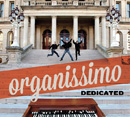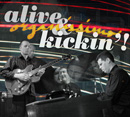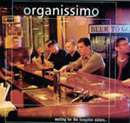Review - The Leslie 3300, page 4
by Jim Alfredson
(continued from page 3)
The Leslie 3300 looked great on stage and I had no trouble hanging with the guitarist's Fender Bassman. With Root Doctor I don't have to worry about kicking bass, so the low-frequency response problems I had with organissimo were not an issue. Everybody in the band commented how clear and defined the Leslie 3300 sounded and it was thrilling to have so much headroom. I could really milk the dynamics of a solo from very soft to really loud, even with the Leslie 3300 only up halfway. In fact, I had to be careful again not to overpower the rest of the instruments on stage. I can't imagine opening the 3300 up full bore!
AFTER THE GIGS
Back home I decided I would try to determine why the low frequencies of the 3300 were not satisfying with organissimo . I did several tests with a logarhythmic sine-wave sweep from 10Hz to 20kHz using the 3300's 1/4" line input. Under 40Hz or so, the sound totally drops off. 40Hz itself is quite low in volume. In fact, it isn't until about 70Hz or so that the 3300 seems to really come alive. I did some voltage tests on the back of the 15" woofer to make sure the amp was actually feeding the speaker those low frequencies and sure enough it is. From my experiments, I think the woofer probably has a usable frequency range starting at only 55Hz or so. It may even be in the upper 50Hz, low 60Hz range. I called Eminence and spoke with an engineer, but he would not give me the specs on the woofer since it is Hammond's own design (Eminence merely manufacture them to Hammond's specifications). I also spoke with a tech at Hammond-Suzuki and he was unfortunately no help either, unable to give me a definitive frequency response range.
I may replace the woofer with one that has a better low frequency range, but that might impact the other frequencies. For right now, the easiest and least expensive fix is to use the Yorkville NX55P to supplement the bass, via the sub output of the 3300. The combination works very well and sounds great, so why mess with a good solution?
IN SUMMARY
The 3300 represents both a big step forward and a slight step backward in Leslie design. The tonal shaping capabilities are fantastic, especially when you start substituting different tubes in the preamp. The tonal difference between the 3300 and a vintage 122, with the right tube and EQ settings, is negliable at best, especially on stage. The high wattage output is a blessing as is the smaller size and weight. However, the trade-off for the smaller cabinet seems to be weak response in the bass. If you kick bass, you're probably going to have to augment the 3300 with another cabinet, fed by the 3300's sub output. If you don't kick bass, the 3300 will sound great as is and will give you the power and tone you need in almost every situation imaginable.
For me personally, even despite the bass problem, the 3300 is still a great investment. I already haul the Yorkville for my Motif ES Rack, so using it to supplement the bass of the 3300 is not a deal-breaker. The size, weight, and wattage are the main selling points for me and thankfully Hammond-Suzuki did their research and made a Leslie that is tonally similar to the venerable 122. The 3300 is adjustable to any situation and is sturdy, road-worthy, and sounds great. That's enough for me!
ADDENDUM:
I've been using the Leslie 3300 now for several months and I thought I should fill out this review with some feedback on how the Leslie has performed on the road. I am still thrilled by the sound of the 3300; it is full, rich, and loud. But shortly after this review was posted, I began having problems with the upper driver.
In fact, I literally smoked the upper driver on a Root Doctor gig. Unfortunately it was during the second set of a gig in Indianapolis, miles away from home. I had to finish the night playing the XK System through my Yorkville powered speaker and as anyone who has played the XK3 knows, the Leslie sim leaves much to be desired.
The next day a local musician and good friend of mine drove me around to several music stores. No one had a subtable replacement, so he loaned me his Leslie 147 and Trek pedal preamp to get through the next night.
Upon returning home I immediately called Hammond and spoke with Ray Gerlich, the head of Hammond's service department. He was fully aware of the blown driver syndrome and shipped me a new, updated driver that he claimed would solve the problem.
Two weeks later, the driver blew again; during the second set of a show with Root Doctor. Again I was left to finish the gig playing through my Yorkville. I had no choice but to put the 3300 in my garage and use my trusty old 1960s Leslie 122 again while I waited for Hammond to find a real solution to this problem.
Long story short: Hammond did find a solution. It turns out that it is possible under certain circumstances to overload the tube circuit input to such an extent that it will cause the voice coil of the upper driver to heat up and fry. So Hammond sent a me a new driver, a new updated preamp board (that added a resistor to the leg of C15), and an electrolytic cap that went inbetween the upper driver and the amp.
I'm happy to report that since I installed the components, I've had no problems. The 3300 still sounds great and I have absolutely cranked it on big stages with Root Doctor and organissimo and had no issues.
If you are having a problem with your 3300 eating drivers, please call Hammond Service and speak to Ray. He'll make things right.
One more note: For organissimo and other gigs where I have to kick bass, I've been augmenting the 3300 with a Yorkville powered subwoofer fed from the subwoofer output of the 3300. This has made a huge difference. I have tons of headroom along with incredibly low, powerful bass. Going back to a standard tube Leslie is like listening to music on a tabletop radio after hearing it through a set of full-range speakers.
Jim Alfredson is a professional organist with organissimo and Root Doctor. All trademark names copyright their respective owners. This review copyright 2008 by Jim Alfredson.
Check out organissimo and Root Doctor's records at the Big O Store!




